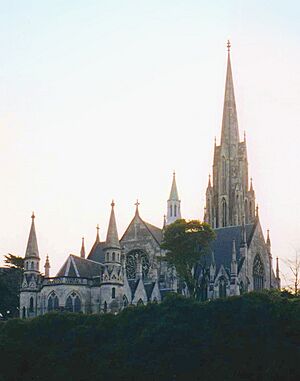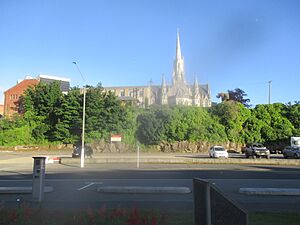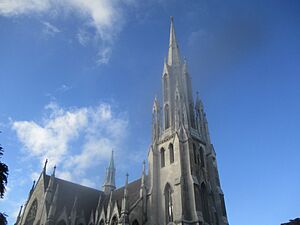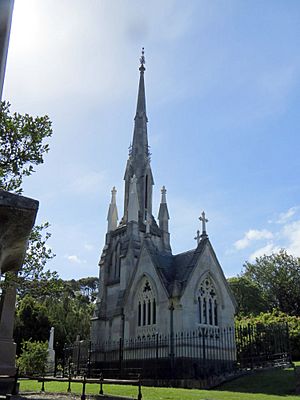First Church of Otago facts for kids
First Church is a very important church in Dunedin, a city in New Zealand. You can find it right in the middle of the city, on Moray Place. It's just a short walk from the city center. It's the main Presbyterian church in Dunedin. Many people think it's the most amazing church built in New Zealand during the 1800s. Heritage New Zealand has listed it as a special Category I building.
Contents
Early Church Buildings
Before the current First Church was built, people in Dunedin used smaller buildings for their church services. The city was growing very fast, so they needed a bigger and stronger church.
The First Buildings
The very first First Church was a simple wooden building. It was built quickly in 1848, just six months after the first European settlers arrived from Scotland. This building could hold about 200 people. At first, there were no seats, so people had to stand during services! Seats were added a few months later.
In 1850, a stone church was built. This made the church much bigger, doubling its size. This building was used for many things. It was a church, a school, and a place for public talks. It even served as the meeting place for the Otago Provincial Council. These early buildings were later used to store wool. Sadly, they were destroyed by fire in 1865.
The Interim Church
From 1864, a third church building was used. It was called "The Interim Church." This was a strong wooden building with a stone base. It could seat 600 people. This church was used until the current First Church was ready in 1873. After that, the wooden building was moved and became a workshop for trams. You can still see parts of its old stone foundations today.
Building the Current Church
The current First Church stands on what's left of Bell Hill. This was a large hill that once split Dunedin in half. When gold was found nearby, Dunedin grew very quickly. The hill became a big problem for the city's growth.
Shaping the Land
The Otago Provincial Council decided to dig away a large part of Bell Hill. This created a big cut where one of the city's main streets, Princes Street, now runs. The hill's height was lowered by about 12 meters (40 feet). Much of the dirt and stone dug out was used to create new land in South Dunedin. The church's spot, on a remaining part of the hill, gives it great views over the city and towards the Otago Harbour.
Designing a Masterpiece
The church was designed in 1862 by Robert Lawson. He was a famous architect who also designed Knox Church in Dunedin, which has a similar tower. Lawson won a competition to design the church.
Building started a bit later because of the work on Bell Hill. The first stone was laid in May 1868 by Dr. Thomas Burns. He was a big supporter of the church project. The church officially opened on November 23, 1873. Sadly, Dr. Burns had already passed away by then.
The church is famous for its tall tower with many pointed tops, called pinnacles. A tall, pointed roof, called a spire, sits on top. The spire is 56.4 meters (185 feet) high. It's special because it has windows on all sides, making it look even taller. Lawson was very particular about his design. He even had the top of the spire taken down and rebuilt because it wasn't perfect enough for him! You can see the spire from many parts of central Dunedin. The church can hold over 1000 people.
Some people thought the church was too expensive. They felt that churches in the countryside, which were often very simple, should have received more money. But Dr. Burns strongly supported the project, so it went ahead.
About the Building

First Church looks a lot like the big Norman cathedrals in England, but on a smaller scale. You can really see its grand, cathedral-like design from the back. It has a rounded end called an apse with small towers on each side. A huge wall with a large round window, called a rose window, stands above them. This rose window is a main feature of the back of the church, after the spire.
Inside, the ceiling is made of wood, not stone like old cathedrals. A stone arch frames the central pulpit, where the minister speaks. Light comes through the beautiful stained-glass rose window above the pulpit. Large organ pipes stand on each side, making the pulpit look balanced.
Height and Materials
At 56.4 meters (185 feet), the spire makes First Church one of the tallest buildings in the South Island. It was the tallest building in the South Island until ChristChurch Cathedral, Christchurch was finished in 1881. It briefly became the tallest again in 1888 after an earthquake damaged the Christchurch Cathedral. Today, First Church is the tallest building in Dunedin.
The church is built from Oamaru stone, which is a light-colored limestone. Its foundations are made of strong dark rock from Port Chalmers. Many of the detailed carvings inside and outside were done by Louis Godfrey. The church has "cathedral glass," which is colored but doesn't have pictures. This was common in Otago's 19th-century churches.
Special Features
First Church has beautiful stained-glass windows. Some of these windows honor soldiers who died in wars and the Otago Mounted Rifles. For many years, the church had a large organ built in 1908. In 1983, it was replaced with a modern digital organ.
In 1975, a full set of eight change-ringing bells was installed. These bells were made by the famous Whitechapel Bell Foundry. Bellringers from the Australian and New Zealand Association of Bellringers ring them regularly. At the time, it was the only set of such bells in a Presbyterian church outside the United Kingdom. It was also said to be the southernmost set of bells in the world.
Outside the church, there is a large bell on a stand. This bell was sent from Scotland in 1851. You can also find a memorial plaque for Dr. Burns in the church grounds. The entrance gates have two lamps that used to be street lamps in Edinburgh, Scotland. This is another link to the home country of many of Dunedin's first settlers.
A smaller version of First Church was built by Robert Lawson in the Northern Cemetery. It serves as a family tomb for William Larnach, an important early resident of Dunedin.
Current Use
First Church holds regular Sunday services in English, Cook Island Maori, and Samoan. The church is also used for many other events. These include religious gatherings, as well as city and cultural events.
|





